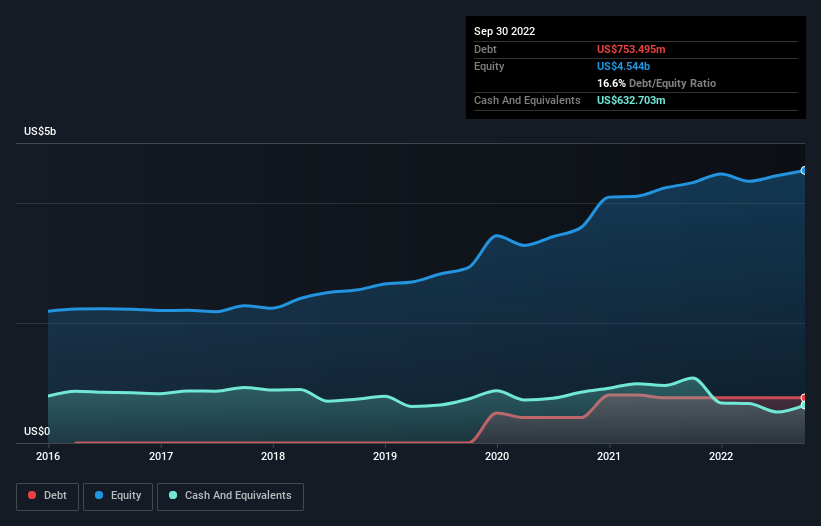
Howard Marks put it nicely when he said that, rather than worrying about share price volatility, 'The possibility of permanent loss is the risk I worry about... and every practical investor I know worries about.' It's only natural to consider a company's balance sheet when you examine how risky it is, since debt is often involved when a business collapses. We note that ANSYS, Inc. (NASDAQ:ANSS) does have debt on its balance sheet. But should shareholders be worried about its use of debt?
What Risk Does Debt Bring?
Debt assists a business until the business has trouble paying it off, either with new capital or with free cash flow. Part and parcel of capitalism is the process of 'creative destruction' where failed businesses are mercilessly liquidated by their bankers. However, a more frequent (but still costly) occurrence is where a company must issue shares at bargain-basement prices, permanently diluting shareholders, just to shore up its balance sheet. Having said that, the most common situation is where a company manages its debt reasonably well - and to its own advantage. When we examine debt levels, we first consider both cash and debt levels, together.
Check out our latest analysis for ANSYS
What Is ANSYS's Net Debt?
The chart below, which you can click on for greater detail, shows that ANSYS had US$753.5m in debt in September 2022; about the same as the year before. However, because it has a cash reserve of US$632.7m, its net debt is less, at about US$120.8m.

How Strong Is ANSYS' Balance Sheet?
Zooming in on the latest balance sheet data, we can see that ANSYS had liabilities of US$609.7m due within 12 months and liabilities of US$1.01b due beyond that. On the other hand, it had cash of US$632.7m and US$763.7m worth of receivables due within a year. So it has liabilities totalling US$221.5m more than its cash and near-term receivables, combined.
Having regard to ANSYS' size, it seems that its liquid assets are well balanced with its total liabilities. So it's very unlikely that the US$21.6b company is short on cash, but still worth keeping an eye on the balance sheet. But either way, ANSYS has virtually no net debt, so it's fair to say it does not have a heavy debt load!
We use two main ratios to inform us about debt levels relative to earnings. The first is net debt divided by earnings before interest, tax, depreciation, and amortization (EBITDA), while the second is how many times its earnings before interest and tax (EBIT) covers its interest expense (or its interest cover, for short). This way, we consider both the absolute quantum of the debt, as well as the interest rates paid on it.
ANSYS's net debt is only 0.18 times its EBITDA. And its EBIT easily covers its interest expense, being 41.8 times the size. So we're pretty relaxed about its super-conservative use of debt. The good news is that ANSYS has increased its EBIT by 7.7% over twelve months, which should ease any concerns about debt repayment. The balance sheet is clearly the area to focus on when you are analysing debt. But it is future earnings, more than anything, that will determine ANSYS's ability to maintain a healthy balance sheet going forward. So if you want to see what the professionals think, you might find this free report on analyst profit forecasts to be interesting.
Finally, a business needs free cash flow to pay off debt; accounting profits just don't cut it. So it's worth checking how much of that EBIT is backed by free cash flow. Over the last three years, ANSYS actually produced more free cash flow than EBIT. There's nothing better than incoming cash when it comes to staying in your lenders' good graces.
Our View
Happily, ANSYS's impressive interest cover implies it has the upper hand on its debt. And the good news does not stop there, as its conversion of EBIT to free cash flow also supports that impression! Considering this range of factors, it seems to us that ANSYS is quite prudent with its debt, and the risks seem well managed. So the balance sheet looks pretty healthy, to us. We'd be very excited to see if ANSYS insiders have been snapping up shares. If you are too, then click on this link right now to take a (free) peek at our list of reported insider transactions.
At the end of the day, it's often better to focus on companies that are free from net debt. You can access our special list of such companies (all with a track record of profit growth). It's free.
New: Manage All Your Stock Portfolios in One Place
We've created the ultimate portfolio companion for stock investors, and it's free.
• Connect an unlimited number of Portfolios and see your total in one currency
• Be alerted to new Warning Signs or Risks via email or mobile
• Track the Fair Value of your stocks
Have feedback on this article? Concerned about the content? Get in touch with us directly. Alternatively, email editorial-team (at) simplywallst.com.
This article by Simply Wall St is general in nature. We provide commentary based on historical data and analyst forecasts only using an unbiased methodology and our articles are not intended to be financial advice. It does not constitute a recommendation to buy or sell any stock, and does not take account of your objectives, or your financial situation. We aim to bring you long-term focused analysis driven by fundamental data. Note that our analysis may not factor in the latest price-sensitive company announcements or qualitative material. Simply Wall St has no position in any stocks mentioned.
About NasdaqGS:ANSS
ANSYS
Develops and markets engineering simulation software and services for engineers, designers, researchers, and students.
Flawless balance sheet with solid track record.
Similar Companies
Market Insights
Community Narratives



